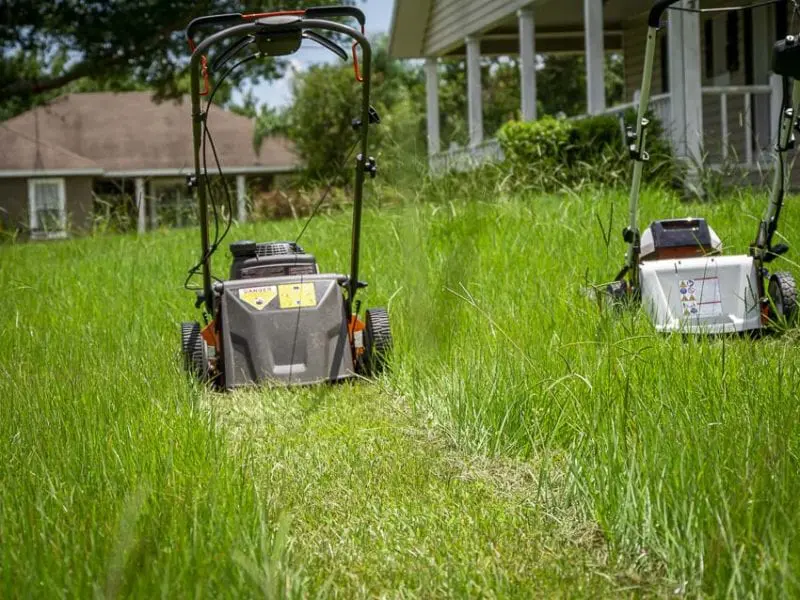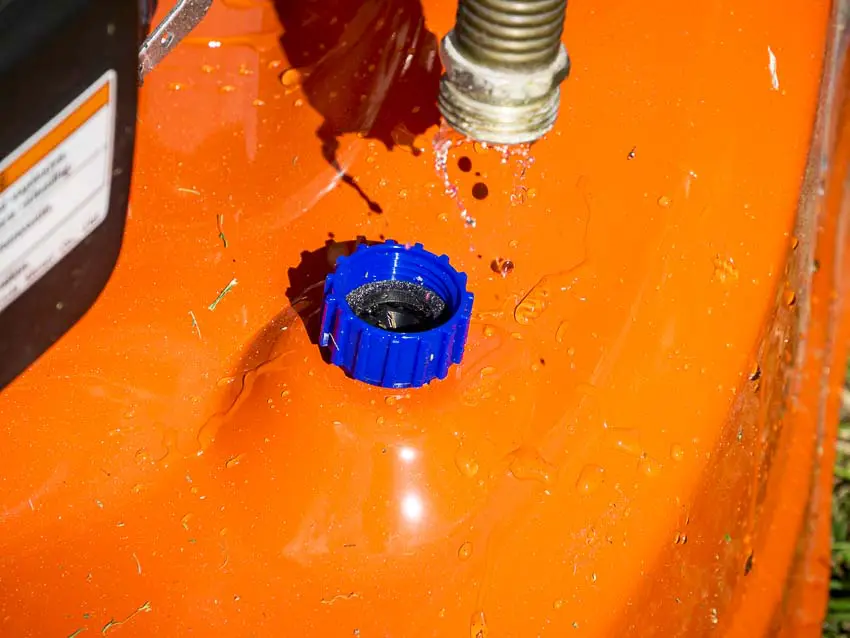Husqvarna’s Workhorse Walk-Behind Finishes Strong
We were dying to know what the best lawn mowers available were, both gas and battery-powered models. So, we brought in 24 different models to see how they performed in a variety of categories. The Husqvarna LC221RH came in as a rear wheel drive self-propelled mower powered by a Honda GCV 160 engine. It showed the kind of consistent performance we like to see across the board that makes for a solid residential option.
Pros
- Excellent fuel efficiency
- Honda GCV160 engine is easy to start
- Relatively quiet
- Great value
Cons
- Height adjustment levers could be more rigid
- Somewhat flimsy drive control (something we regularly see on residential mowers)
Performance
We use a variety of tests to come to our conclusions and you’re welcome to take out word for it. But feel free to check the details for yourself in our best self-propelled lawn mower article.
Cutting Power
We found that the difference between a gas mower’s no-load speed and maintenance speed was virtually identical. As it turns out, your weekly lawn mowing won’t put any real stress on most quality gas mowers.

In the case of the Husqvarna LC221RH, we noted that it could crank out 3021 RPM, putting is blade tips at 188.6 MPH. This is perfectly acceptable for a gas mower and will have no problems with your weekly cut.
We then upped the ante and simulated a heavier load on our mowers. The Husqvarna LC221RH managed dropped to 2949 RPM (184.1 MPH blade tip speed). The dropoff of just 4.5 MPH comes in a close second to Cub Cadet that dropped 4.0 MPH.
Torture Test
All of this information is great, but it’s still mostly information lab work. How do these numbers translate to real-world performance?
We threw some of our better-performing mowers into the deep end by letting our grass grow to excessive heights and thickness for 5 weeks. Then we walked them through it at a 2.5″ cut height and a consistent 2.5 MPH speed. We measured how far each went before the blade stopped.

The Husqvarna LC221RH managed 28.5′ before the stress became the engine couldn’t maintain its momentum anymore. That’s not a bad finish at all, and it actually beat out one of the commercial mowers. However, we could definitely tell the difference between the 160 cc engine and Cub Cadet’s 196 cc that made it out nearly 55′.
It comes as no surprise that Husqvarna’s Honda-powered mower is capable of cutting almost any residential conditions. It breezes through weekly cuts with ease and is very capable of handling a couple of weeks worth of overgrowth.
Cutting Area
We like the power of gas a lot, but one of the reasons that electric mowers have become so appealing is that there’s no fussing with oil and fuel. It’s something that comes to the forefront of our minds when we have to stop and refuel. So how long can you go without stopping?

Under light cutting conditions, we found that the Husqvarna LC221RH can run for 93 minutes on a tank of fuel. Walking at a constant 2.5 MPH, the 21″ cutting swath of the covers up to 35,689 square feet worth of mowing on a tank of fuel. In more understandable terms, that’s 0.82 acres of grass—almost dead even with Craftsman’s M310.
Those are ideal conditions, and keep in mind that most of lose 5%–10% just overlapping our cutting lanes.
Fuel Efficiency
Of course, cutting area is part of the equation. We also like to know how efficient an engine actually is. After all, fuel hits you right in the wallet.
The Husqvarna LC221RH has one of the smallest tank sizes at 36 oz. However, running on the same 4 oz of Trufuel that we put in every tank for this portion of our testing, the Husqvarna ran for 10.3 minutes. That’s actually the most fuel-efficient of all the gas mowers we tested in terms of engine runtime.

Teased out, we can see what this sort of efficiency translates out to in more practical terms. It works out to an efficiency of 2.91 acres of mowing per gallon. It gets beat only by Cub Cadet who has a little less runtime per gallon but gets an area boost from its 23″ blade.
If you want to walk in a straight line at 2.5 MPH, the Husqvarna’s Honda GCV160 engine gets a cool 13.73 MPG.
Noise
The Husqvarna LC221RH sounded off at a really reasonable 89 dB(A). It’s not going to be quieter than any of the battery-powered models we tested, but it’s still the quietest-running gas-powered mower in the residential section of the test. Only Honda’s commercial model came in quieter, but it’s in a different class.
Feature Set
Self-Propelled Drive
Given that our gas mowers weigh a fair bit more than their battery-powered counterparts, we appreciated that all of the gas mowers we tested included a self-propelled drive.
Some of the designs we saw were better than others. While the Husqvarna’s drive control design is plenty effective, it feels a little on the flimsy side. Other mowers employ this design as well, and in all of these cases, we feel they could stand to tighten up the rigidity.

The LC221RH employs a rear wheel drive that is plenty effective and powerful enough. You can control your walking speed by squeezing on the drive handles, controlling the variable speed anywhere from 0-3 MPH.
Deck Material
Husqvarna, like just about every other gas-powered mower we tested, uses a steel deck. We see this as a positive thing, as it’s going to be a whole lot more durable than the poly or plastic decks that we’ve seen on some of the electric mowers.
Of course, the tradeoff here is that the steel will be substantially heavier, but since this mower will be pushing itself, it doesn’t bother us much.

Height Adjustment and Range
Husqvarna uses a 4-point adjustment system for the LC221RH. That means that when you need to adjust your deck height, you’ll have to go around to each wheel to set your height. That’s the norm for gas mowers since the weight of the builds can create a weakness for single point adjustments.
While the system works well, we noticed that the levers are a little thinner than others and they aren’t as rigid as other mowers in this class.

It has 9 height levels to choose from that range from 0.75″ to 4.125″. The range here is excellent, and ought to be able to handle just about every grass species you’re likely to deal with.
Handle Positions
There are two handle positions to work with. Most mowers go with three, so there’s not quite as much versatility there.
Discharge Options
This mower allows for mulching, bagging, and side discharge of your mower clippings. Everything you need for all three options comes in the box.
Additional Features
- Integrated deck wash
- Auto choke system
- Fuel cut-off valve
Value
The Husqvarna LC221RH can be yours for $409.95 from your local Husqvarna dealer. Amazon has them as well, but the prices we’re seeing currently are higher. It also comes with a 3-year warranty.
This price, coupled with the warranty, features, and performance, earn the LC221RH the second-highest value score of any of the gas-mowers we tested, right behind Craftsman.
The Bottom Line
If you’re in the market for a quality residential lawn mower in the sub-$400 class, it’s tough to turn down the Husqvarna LC221RH and its Honda engine. The cutting performance and fuel efficiency are excellent. As a bonus, it’s really quiet for a gas model.
There are a couple of minor weaknesses, but nothing that would make us turn away from this model. It’s a great choice for lawn sizes up to 3/4 acre or perhaps an acre. If your lawn is much larger, just know the 36-ounce fuel tank is going to force into a pit stop for refueling.
Husqvarna LC221RH Mower Specs
- Motor: Honda GCV160
- Displacement: 9.8 cu.inch
- Fuel Tank Volume: .25 gal
- Engine Lube Type: Splash
- Engine Cooling: Air
- Drive: Rear wheel
- Speed: 0-3 mph
- Cutting Width: 21″
- Adjustment: 4-point
- Cut Range: 1″ – 4″
- Wheel Size: 8″ (front); 11″ (rear)
- Deck Material: Steel
- Weight: 79.2 lbs
- Warranty: 3-year
- Price: $409.95 from your local Husqvarna dealer or online
For more information about the Husqvarna LC221RH, visit Husqvarna.com.






